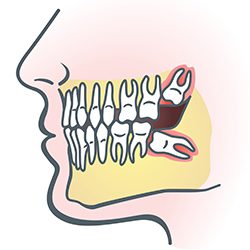Specialty Services in Tempe, AZ

Why race across town to dentists you don’t know?
We provide comprehensive, specialized dental care in one familiar place.

Nitrous oxide, or laughing gas, is the most frequently used method for easing mild to moderate anxiety. Administered through a small mask that fits over your nose, it is an effective way to calm anxiety, raise your pain threshold, and even make time seem like it’s passing quicker than usual. As the gas begins to work, you will become calm, although you will still be awake and able to talk with the dentist.
At the end of your appointment, you’ll resume breathing regular oxygen, and all the effects of nitrous oxide will disappear, so you can resume your normal activities immediately.
Have You Tried a CPAP and Failed?
Does your snoring affect your sleep and/or someone else’s? Looked for other over the counter products to help you sleep better but nothing is working?
Look no more!
CPAP is, presently, the most effective treatment for obstructive sleep apnea. However, if you cannot tolerate or are not using it, then it has no benefit. If that sentence applies to you, then keep reading.
I want to take the time to discuss with you a method that can help you end snoring fast and reduce or eliminate sleep apnea. Oral appliances are intended to treat apnea by keeping the airway open—they work by pushing the lower jaw forward and preventing the tongue from falling back and collapsing the airway. The goal is to achieve the maximum benefit at the most comfortable and effective position for the patient.
Not all dentists have the necessary knowledge of sleep apnea, so if you wish to pursue this therapy, ask your sleep doctor or primary care to refer you to a dentist who is familiar with apnea and who works with oral appliances.
Snoring Therapy
What causes snoring?
Snoring is caused by the vibrations of your soft and/or hard tissue palates; these vibrations occur because of increasingly narrow air passages. When air passes through these passages, a “flapping” sound occurs because the tissue is soft in nature. Surgery (to alleviate the snoring) is not always successful, however, because the sound may not originate from the soft palate; the snoring sometimes originates from tissues in the upper airway.
Common causes for snoring
- Smoking
- Alcohol
- Health Problems
- Obesity
- Obstructed Nasal Passages – Deviated Septum
- Poor Muscle Tone of the Tongue
- Daytime Fatigue
- Sleep Apnea
- Hypothyroidism
- Allergies
Sleep Apnea
Loud snorers may have a more serious case of blocked air passages, known as obstructive sleep apnea syndrome (OSA).
In these cases, the blockage of air is so great that no air can get through, causing repeated awakenings throughout the night.
Obstructive sleep apnea can contribute or lead to many other conditions, such as high blood pressure, stroke, heart attack and depression, so it is important to be diagnosed by a medical professional if you experience any sleep-related symptoms.
Temporomandibular Disorder (TMD)

Millions of Americans suffer from chronic facial and neck pain as well as recurring headaches. In some cases, this pain is due to Temporomandibular Disorder, or TMD.
Your temporomandibular joints (TMJ) connect your lower jawbone to your skull. These joints get a lot of use throughout the day as you speak, chew, swallow, and yawn. Pain in and around these joints can be unpleasant and may even restrict movement.
Symptoms of TMD include:
- Pain in the jaw area
- Pain, ringing, or stuffiness in the ears
- Frequent headaches or neck aches
- Clicking or popping sound when the jaw moves
- Swelling on the sides of the face
- Muscle spasms in the jaw area
- A change in the alignment of top and bottom teeth
- Locked jaw or limited opening of the mouth
Should you notice any of these symptoms, let your doctor know. Your dentist can help indicate the presence of TMD and create an effective treatment just for you.
There are a few simple steps you can take at home or work to prevent TMD from becoming more severe, or to prevent it from occurring:
- Relax your face — remember the rule: “Lips together, teeth apart”
- Avoid grinding your teeth
- Avoid constant gum chewing
- Don’t cradle the phone receiver between your head and shoulder — either use a headset or hold the receiver in your hand
- Chew food evenly on both sides of your mouth
- Do not sit with your chin rested on your hand
- Practice good posture — keep your head up, back straight, and shoulders squared

There are times when it is necessary to remove a tooth. Sometimes a baby tooth has misshapen or long roots that prevent it from falling out as it should, and the tooth must be removed to make way for the permanent tooth to erupt. At other times, a tooth may have so much decay that it puts the surrounding teeth at risk of decay, so your doctor may recommend removal and replacement with a bridge or implant. Infection, orthodontic correction, or problems with a wisdom tooth can also require removal of a tooth.
When it is determined that a tooth needs to be removed, your dentist may extract the tooth during a regular checkup or may request another visit for this procedure. The root of each tooth is encased within your jawbone in a “tooth socket,” and your tooth is held in that socket by a ligament. In order to extract a tooth, your dentist must expand the socket and separate the tooth from the ligament holding it in place. While this procedure is typically very quick, it is important to share with your doctor any concerns or preferences for sedation.
Once a tooth has been removed, neighboring teeth may shift, causing problems with chewing or with your jaw joint function. To avoid these complications, your dentist may recommend that you replace the extracted tooth.

Wisdom teeth are types of molars found in the very back of your mouth. They usually appear in the late teens or early twenties, but may become impacted (fail to erupt) due to lack of room in the jaw or angle of entry. When a wisdom tooth is impacted, it may need to be removed. If it is not removed, you may develop gum tenderness, swelling, or even severe pain. Impacted wisdom teeth that are partially or fully erupted tend to be quite difficult to clean and are susceptible to tooth decay, recurring infections, and even gum disease.
Wisdom teeth are typically removed in the late teens or early twenties because there is a greater chance that the teeth’s roots have not fully formed and the bone surrounding the teeth is less dense. These two factors can make extraction easier as well as shorten the recovery time.
In order to remove a wisdom tooth, your dentist first needs to numb the area around the tooth with a local anesthetic. Since the impacted tooth may still be under the gums and embedded in your jaw bone, your dentist will need to remove a portion of the covering bone to extract the tooth. In order to minimize the amount of bone that is removed with the tooth, your dentist will often “section” your wisdom tooth so that each piece can be removed through a small opening in the bone. Once your wisdom teeth have been extracted, the healing process begins. Depending on the degree of difficulty related to the extraction, healing time varies. Your dentist will share with you what to expect and provide instructions for a comfortable, efficient healing process.
